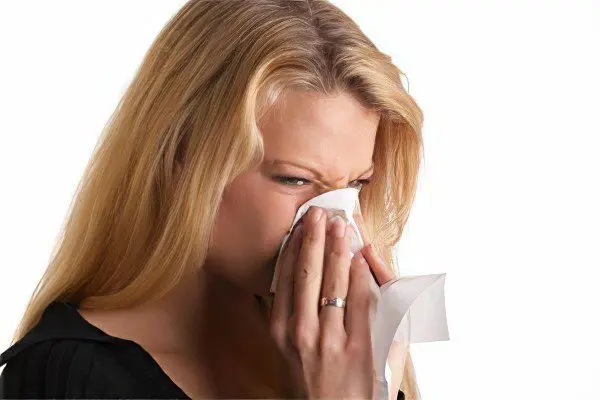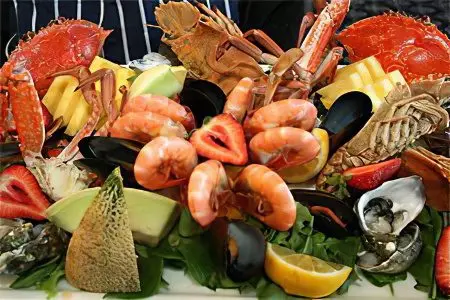Contents
Food allergy is a reaction of the human immune system when the protective system perceives the incoming food protein as a foreign agent.
Causes of food intolerance
Food intolerance cannot be due to any one cause.
This is a multifactorial reaction of the body, among the main reasons for which:
The reaction is pseudo-allergic;
mental illness;
enzyme deficiency.
Pseudo-allergic reactions

If there is a pathology of the gastrointestinal tract, then the occurrence of a pseudo-allergic reaction is not uncommon. In violation of the state of the intestinal mucosa, exogenous histamine liberators receive increased access to mast cells. For example, when eating fish, food supplements, berries, reactions that have not been observed before may occur. At the same time, they have symptoms similar to allergies, but in the blood, allergic lgE antibodies remain at the normal level. Most likely this is due to the fact that multiple mast cells, which are located throughout the intestine, as well as outside it, begin to release biologically active substances. Against this background, such reactions of the body as: Quincke’s edema, urticaria occur and periodically repeat. At the same time, the patient had not previously suffered from allergies.
In addition, pseudo-allergic reactions may be due to low histaminase activity. This occurs when the mechanisms responsible for the deactivation of biologically active substances fail.
Products that contain a lot of histamine can provoke the development of a reaction. For example, this can happen when drinking red wine or tuna (400 mg per 100 g).
Tyramine can cause headaches, vomiting, and nausea. This substance is rich in herring in the marinade, as well as brewer’s yeast. Pathological reactions that occur to the intake of tyramine occur when microbial biocenosis is disturbed inside the intestine.
In addition, to provoke intolerance to certain foods can be due to the intake of tartrazine in the body. This orange dye can often be found in carbonated drinks, marmalade, confectionery creams, etc. Intolerance occurs due to a metabolic failure responsible for the absorption of arachidonic acid. As a result, prostaglandins begin to form in the body, which can provoke suffocation in the patient.
Food intolerance associated with enzyme deficiency
Due to enzyme deficiency, the following types of food intolerances may occur:
Lactase deficiency, which helps break down milk sugar molecules, causes cow’s milk intolerance. Most often, this feature of the body is found in residents of Asian and African countries. At the same time, people suffer from flatulence and diarrhea.
Sucrose deficiency can provoke diarrhea, which occurs against the background of a violation of sugar fermentation. This pathology is less common.
If a person suffers from celiac disease, then their intestines will not be able to ferment and metabolize gluten normally. It is found in wheat and some other foods. In this case, the patient will suffer from diarrhea and other digestive disorders. If a person begins to adhere to a gluten-free diet, then the state of his digestive system is normalized. However, if the disease is not treated, severe pathology can develop, up to atrophy of the intestinal villi and the development of oncological diseases. When the disease is diagnosed in people, IgG antibodies are detected in the blood, which are produced to fight gliadin. This substance, in turn, is a component of gluten.
Food intolerance due to mental illness
This problem is much more common than it might seem. Psychological problems can cause intolerance to certain foods. Sick people complain of various symptoms, including: headaches, nausea and vomiting, increased weakness, and therefore they refuse to take many foods. Against the background of rejection, anemia can develop, a drop in the level of protein in the blood. Treatment of anorexia nervosa is impossible without the advice of a psychiatrist. In such patients, in parallel with changes in eating behavior, hysterical, depressive and anxiety disorders, and a violation of adaptation can be observed.
Food allergies can manifest themselves in different ways. Some patients suffer from diarrhea, abdominal pain, nausea and vomiting. In this case, there is a clinic of gastritis of an allergic nature and enterocolitis. Strengthening the motor function of the intestine, changes in the morphology of the gastric and intestinal mucosa can be explained by the action of peptic hormones. They are produced by apudocytes – secreting cells of the stomach and duodenum.
Separately, it is worth noting such diseases as enterocolitis and eosonophilic gastritis. They develop in the absence of the participation of IgE antibodies.
Some patients experience other symptoms of allergic food intolerance, including: stomatitis, cheilitis, angioedema, atopic dermatitis, urticaria, runny nose, suffocation.
Most often, a pathological reaction is provoked by such foods as crustaceans and molluscs, corn and wheat, hazelnuts and peanuts, eggs and cow’s milk.
List of allergenic foods
There are certain foods that are more likely than others to provoke an allergic reaction in humans. With a tendency to allergies, they should be eaten with extreme caution.

People who have been diagnosed with allergies should not forget that they should not eat the following foods:
Chocolate, coffee, cocoa. The reaction to these foods is increased by cross-allergy to legumes. As a rule, caused by theobromine and caffeine, which are part of them;
Smoked products, semi-finished products. Without preservatives, food additives, they practically do not exist. And these are powerful provocateurs of both true and pseudo-allergic reactions. It has been established that the smoking process leads to the formation of many carcinogenic substances;
Mushrooms. They have a lot of protein, which is the reason for heavy fermentation. Their cellular wall contains a lot of chitin and β-glucan (polysaccharide);
pulse: beans, peas, lentils, peanuts – the richest sources of plant proteins, which serve as allergens;
Milk. In addition to casein, its composition includes antibodies for the formation of immunity in the passive form of the young animals from which it is obtained (cows, goats, etc.);
Eggs. They are rich in albumin protein and other nutrients that are needed for the development of the bird embryo. They can also be the cause of the reaction;
Fish and seafood. They contain a protein M-antigen that is resistant to processing at high temperatures;
Vegetables and fruits. If a person already has an allergy to pollen, then the reaction may occur to fruits and vegetables in which the pollen is similar (in structure). This mainly refers to representatives of the same genus, for example, willow, poplar, apples;
Meat. It is made up of a lot of protein. Its ability to sensitize falls during heat treatment during the cooking period;
Cereals. These are gluten, albumin and gliadin, especially these components are abundant in wheat.
It must be remembered that almost all food allergies (90% of them) provoke eight foods. These are nuts, milk, eggs, shellfish, fish, peanuts, soy and wheat.
Allowed Products
A safe diet involves the elimination of first-order allergens and moderate consumption of second-order allergens.
The diet can include dishes that are prepared in such a way that it undergoes partial fermentation, prepared from the following products:
meat, but only low-fat varieties can be used;
white and green vegetables;
croup;
offal;
products specific to the place of residence.
You can eat:
Semolina, rice, barley, oatmeal.
Skimmed dairy products without additives. The emphasis should be on home-cooked cottage cheese, fermented baked milk and kefir.
Include only lean meats in your diet: turkey, lean beef, rabbit meat, and others.
Pork, beef offal are also suitable: liver, kidneys, tongue.
As for fish, preference should be given to cod and sea bass.
Replace bread with: buckwheat, rice or cornbread.
You can eat butter, sunflower, olive oil.
Cabbage of different types: white, cauliflower, Brussels sprouts;
Also the following vegetables: squash, swede, cucumbers, zucchini, turnips, broccoli, green lettuce, spinach, herbs, garlic;
Fruits and berries: apples (green varieties), pears, white currants and cherries, gooseberries.
From drinks, choose non-carbonated mineral water, compotes from fresh and dried apples, pears, gooseberries. Give preference to a decoction of wild rose, weakly brewed tea.
Hypoallergenic diet 5HA
The abbreviation “GA” stands for “Hypo” + “Allergenic”. The basic table No. 5 is taken as the basis, but all seafood, fish, caviar, eggs, processed cheeses, ice cream, bell peppers, pickles, sauerkraut, peanuts, sesame seeds, hazelnuts, seeds, citrus fruits, strawberries, apricots, peaches, raspberries are additionally excluded , grapes, pomegranates, pineapple, melon, sea buckthorn, kiwi, semolina and wheat groats, whole milk, flavored fruit drinks, cakes, chocolate, marshmallows, marshmallows.
Most allergenic foods

Almost any product, with the exception of sugar and salt, will have allergic properties.
More often than others, those products provoke a pathological reaction of the body, in which the molecular weight of the glycoprotein in which ranges from 10 to 67 thousand. Most often, they are resistant to temperatures, dissolve well in water, and are poorly affected by proteolytic enzymes and acids.
In America, a study was conducted in which a placebo test took place. On its basis, conclusions were drawn regarding the fact that up to 93% of all allergic reactions are caused by only 8 products. If you put them in order, starting with the most “dangerous”, then eggs will come first, followed by peanuts. The third line is given to soy, followed by nuts (forest), wheat completes the list, only fish and representatives of crustaceans are ahead of it. In addition, scientists note that chocolate is actually not as powerful an allergen as is commonly believed.
The most common cause of death from an anaphylactic reaction in both adults and children is the consumption of fish, peanuts, hazelnuts and crustaceans. In addition, additional risk factors that more often led to the death of people are considered to be the presence of a history of bronchial asthma and untimely administration of adrenaline.
Food allergies are more common in children than in adults. This is due to the fact that their intestinal wall is more permeable, the enzymatic function is not fully developed. All this allows undigested proteins to more easily enter the bloodstream and provoke pathogenic reactions.
Chicken eggs. It is worth knowing that protein and yolk do not cause the same degree of severity of an allergic reaction. After heat treatment, the protein becomes less allergenic. Trying to replace chicken protein with duck or goose protein is impractical, since its proteins are not specific. If a person has a reaction to eggs, then it will manifest itself when consuming poultry meat. In addition, people are often unable to consume foods that contain eggs, such as ice cream, candy, bread, etc. In addition, it is important to remember that some vaccines contain chicken protein impurities, so they should not be administered to people with special sensitivity to this product. So, vaccination against influenza, typhoid or fever can provoke the death of the patient.
Cow’s milk. It contains 20 proteins, with a greater or lesser degree of allergenicity. Some proteins are destroyed when the milk is boiled, which happens after 20 minutes, so some people can drink it after this treatment. If there is sensitivity to ordinary milk, then it will manifest itself both to dry and to its condensed counterpart. However, it is possible to replace it with a goat. Often people who are allergic to milk do not have it to cheese.
A fish. This is the most dangerous product in terms of the development of allergic reactions. Sometimes patients may experience an attack even after inhaling its vapors, which are released during cooking. In this case, it is not possible to carry any fish. Such an allergy most often haunts a person throughout his life. It is worth noting that some people can eat canned fish, as such cooking helps reduce its allergenic properties. In addition, they sarcoplasmic substances are modified during lipophilic drying, this should be taken into account when performing a test using allergens from fish.
Meat. As for meat products, if there is a pathological reaction to one type of meat, the patient calmly tolerates another (he cannot eat lamb, but does not react to pork or poultry), which is explained by the different antigenic composition of animals. It is worth considering that if you are allergic to horse meat, you can not inject tetanus serum.
Lobsters, crayfish, shrimp and crabs. If a person has an allergic reaction to any representative of crustaceans, then they should all be excluded from food.
Cereals. Oats, rye, wheat, corn and rice rarely provoke allergies, but buckwheat can cause severe allergies. If there is an increased sensitivity to cereals, then it is worth remembering that they are part of many sausages, as well as cosmetics.
Berries, vegetables and fruits. Often allergic to them is observed in people who are unable to tolerate tree pollen. After heat treatment, they become less allergenic.
Nuts. Very often, it is they who cause serious pathological reactions, even if they enter the body in small quantities. It is important to remember about their wide application in confectionery.
Condiments. Often, people who are unable to tolerate plant pollen are allergic to them.
It is not uncommon for the pathological reaction to disappear in children when they reach the age of three. Allergy to soy, eggs, milk passes. In addition, high temperatures can reduce their aggressive effect on the body.
The Most Helpful Supplements for Allergies

To prevent allergic reactions, it is important not only not to eat certain foods, but it is necessary to ensure that the body receives useful components that weaken their manifestation.
Omega 3. It is necessary to focus on Omega-3. Omega-3 fatty acids, when taken correctly, help allergy sufferers to preventively maintain their condition. They inhibit the activity of an enzyme that is involved in the formation of prostaglandins that stimulate the development of the reaction. What foods are high in omega 3?
Rosemary acid. Many researchers have concluded that the benefits of rosmarinic acid for allergy sufferers are enormous. It affects leukocytes and immunoglobulin, suppresses allergies. Rosmarinic acid is found in many herbs (oregano, lemon balm, rosemary, sage, mint, thyme).
quercetin. Eat as many foods with quercetin as possible. This substance is antioxidant, antihistamine and anti-inflammatory, it significantly alleviates unpleasant manifestations. Quercetin is found in apples, capers, red onions, cranberries, cherries, raspberries, cranberries, red grapes, broccoli, lovage.
Vitamin C. An important antioxidant vitamin C, it helps reduce symptoms in people with allergies. Experts say that sufficient intake of ascorbic acid helps to reduce the production of histamine in the body. And he, just, also participates in the majority of allergic reactions. Vitamin E will help enhance this process. To create the maximum barrier to allergies, you should use vitamins C and E together. What foods contain the most vitamin C?
Selenium. A place for selenium should always be allocated on the table! By diversifying your diet with mushrooms, cod, shrimp, halibut, you fill your body with this mineral, it is contained in these products in maximum quantities. This microelement affects allergic manifestations by producing unique proteins with antioxidant properties. To achieve the maximum effect in the fight against allergies, it is important to combine products containing selenium with vitamin E.
Vitamin E Allergy hater. Various studies have shown that vitamin E is most useful for suppressing allergic manifestations. Only one experience with the participation of 2500 people showed that the regular consumption of products containing tocopherol (vitamin E) actively reduces the manifestation of allergies. The researchers reported that just one milligram of tocopherol was able to reduce the concentration of antibodies in the blood by more than five percent. What foods contain more vitamin E?
Probiotics. Many experts agree that gastrointestinal health plays a key role in preventing allergic reactions. One way to improve gut health is to consume foods rich in probiotic bacteria such as lactobacilli and bifidobacteria. These beneficial microorganisms live in the gastrointestinal tract, where they promote proper digestion and also prevent the growth of disease-causing bacteria. The best probiotic products: kefir, yogurt, sour milk, which are especially useful after taking antibiotics that destroy the microflora.
Also, a few herbs are of particular note:
Spirulina – otolaryngologists agreed that taking spirulina can greatly improve the condition of people suffering from “hay fever” – manifestations of seasonal allergies to pollen and poplar fluff. It is recommended to take one teaspoon per day.
Butterbur – with manifestations of allergic reactions, an infusion of the plant (500 mg per day) helps, which perfectly replaces drugs such as suprastin or tavegil.
Nettle – 300-500 mg of extract twice a day, or as an infusion.
Chamomile (according to 1 st. L. Of infusion 3-4 once a day, prepare the infusion from 1 st. L. Of herbs to a glass of boiling water)
Unfortunately, in recent years, the number of diseases diagnosed with seasonal, food allergies has increased dramatically. Medications provide relief to patients but do not provide the degree of protection that natural products can provide. Pay attention to nutrition – strengthen your immunity.









